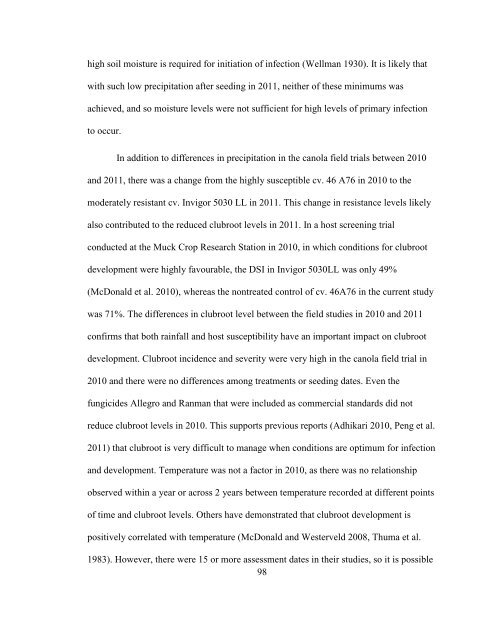Hema Kasinathan Thesis May 1 2012.pdf - Atrium - University of ...
Hema Kasinathan Thesis May 1 2012.pdf - Atrium - University of ...
Hema Kasinathan Thesis May 1 2012.pdf - Atrium - University of ...
You also want an ePaper? Increase the reach of your titles
YUMPU automatically turns print PDFs into web optimized ePapers that Google loves.
high soil moisture is required for initiation <strong>of</strong> infection (Wellman 1930). It is likely thatwith such low precipitation after seeding in 2011, neither <strong>of</strong> these minimums wasachieved, and so moisture levels were not sufficient for high levels <strong>of</strong> primary infectionto occur.In addition to differences in precipitation in the canola field trials between 2010and 2011, there was a change from the highly susceptible cv. 46 A76 in 2010 to themoderately resistant cv. Invigor 5030 LL in 2011. This change in resistance levels likelyalso contributed to the reduced clubroot levels in 2011. In a host screening trialconducted at the Muck Crop Research Station in 2010, in which conditions for clubrootdevelopment were highly favourable, the DSI in Invigor 5030LL was only 49%(McDonald et al. 2010), whereas the nontreated control <strong>of</strong> cv. 46A76 in the current studywas 71%. The differences in clubroot level between the field studies in 2010 and 2011confirms that both rainfall and host susceptibility have an important impact on clubrootdevelopment. Clubroot incidence and severity were very high in the canola field trial in2010 and there were no differences among treatments or seeding dates. Even thefungicides Allegro and Ranman that were included as commercial standards did notreduce clubroot levels in 2010. This supports previous reports (Adhikari 2010, Peng et al.2011) that clubroot is very difficult to manage when conditions are optimum for infectionand development. Temperature was not a factor in 2010, as there was no relationshipobserved within a year or across 2 years between temperature recorded at different points<strong>of</strong> time and clubroot levels. Others have demonstrated that clubroot development ispositively correlated with temperature (McDonald and Westerveld 2008, Thuma et al.1983). However, there were 15 or more assessment dates in their studies, so it is possible98
















